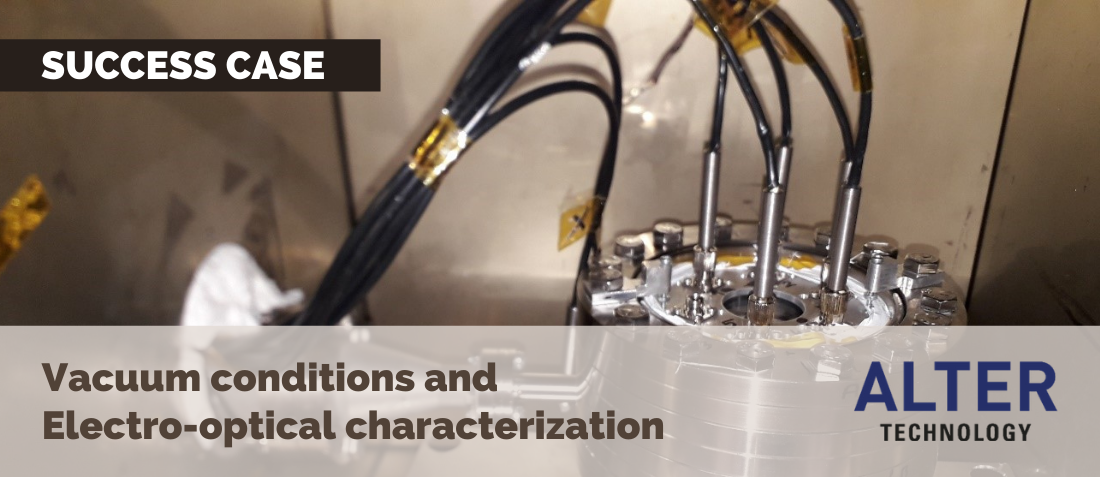
IR SOURCES THERMAL VACUUM CYCLING CHARACTERIZATION
- Posted by Alejandro López Moya
- On February 11, 2022
- 0
Thermal conductivity: the most challenging point to achieve
Every time a component is tested in extreme temperature conditions, it becomes challenging to design a reliable test setup. If, in addition, members must be in vacuum conditions and electro-optical characterization is required at different temperatures, complexity increases exponentially.
One of the most challenging points is sound heat transmission in vacuum conditions. Thermal conductivity must be ensured to allow components to reach the required temperatures when shallow temperatures are required in a vacuum; a good test setup design is the key to a successful test.
Challenge point: Thermal conductivity
In the case of this example, within the framework of Qualification tests, components were cycled between +96ºC and -183ºC while in vacuum conditions. To achieve such really low temperatures, a climatic chamber fed with liquid Nitrogen was used. This chamber allows us to reach temperatures from 250ºC to -196ºC, with a temperature slope of ±2-3ºC/min in vacuum conditions and ±40ºC/min in ambient pressure conditions.
Samples were placed inside a vacuum pot, and this vacuum pot was put inside the climatic chamber. One of the multiple vacuum pumps available at our facilities was used. This pump allows us to reach vacuum levels up to 1·10E-07 mbar.
Electro-optical characterization was required at different temperatures in several cycles, so IR sources were powered with a precision SMU (Keithley 2602B). The temperature was controlled at the component level with several type T thermocouples. A sweep from 500nm to 2500nm was required for characterization, so one IR-VIS monochromator was used with one photodiode at its output.
This PD was used to convert light emitted by IR sources at every wavelength tested to the electrical domain. As we had to measure light from the inside of the pot to the outside of the vacuum system, a Sapphire window was placed at the top of the vacuum pot. An optical fiber bundle was in charge to drive light from every sample to the monochromator.
The following block diagram shows the concept of test setup used:

Figure 1- Block diagram for Thermal Vacuum cycling test setup
As explained before, an excellent thermal conductivity was the key to achieving these temperatures at the component level, so one mechanical support had to be designed to place components and allow thermal conductivity from the baseplate of the vacuum pot. In addition, components had to be perfectly aligned with optical fibers for a perfect characterization, so one additional support was designed to fit these fibers and allow an ideal alignment with the IR sources.

Figure 2- Vacuum pot inside climatic chamber ready for Thermal Vacuum Cycling test
Labview: the control of the entire test
A LabVIEW application was developed to control the entire test, from thermal cycling control to monitoring and recording all test data. This software was also designed to carry out Electro-optical characterization of the whole batch of samples, so it was responsible of controlling all equipment involved in the test. All equipment was interconnected by a GPIB link.
Satisfactory result: Although initially test setup design and requirements for this test were quite complicated, finally, all results were satisfactory, and all IR sources continued successfully with the Qualification test sequence.
Thermal Vacuum

Thermal Vacuum Testing is necessary to be carried out because the environmental conditions in the space are extreme, the combination of low pressure and the extreme temperatures can cause the failure of a component. That is why in Alter Technology, we test the components in similar conditions.
The Thermal Vacuum chamber is the equipment mainly used to simulate environmental space conditions. The most common Thermal Vacuum Chamber (TVC) applications are related to the performance test, control of the thermal cycle, and testing of components, subsystems, and complete satellites in a fully controlled environment. The tests can accurately reproduce the conditions of the space through the simultaneous control of pressure and temperature.
GET IN TOUCH TODAY!
Do you have questions? Contact us!
ALTER TECHNOLOGY LAB EXPERIENCE
- IR SOURCES THERMAL VACUUM CYCLING CHARACTERIZATION - February 11, 2022
- Lasers Endurance Characterization in Vacuum Conditions – Test Setup - January 25, 2022
- Calibration Sources in Vacuum Conditions - January 13, 2022


0 comments on IR SOURCES THERMAL VACUUM CYCLING CHARACTERIZATION